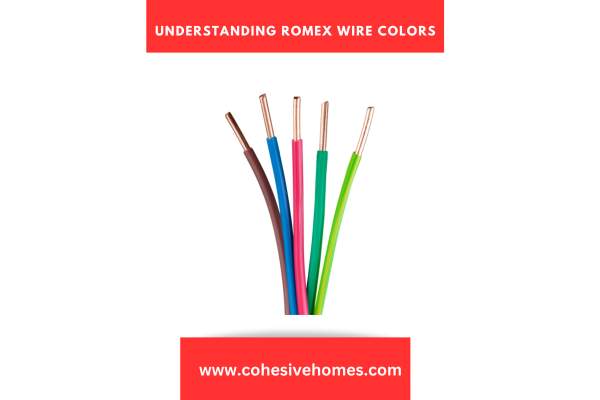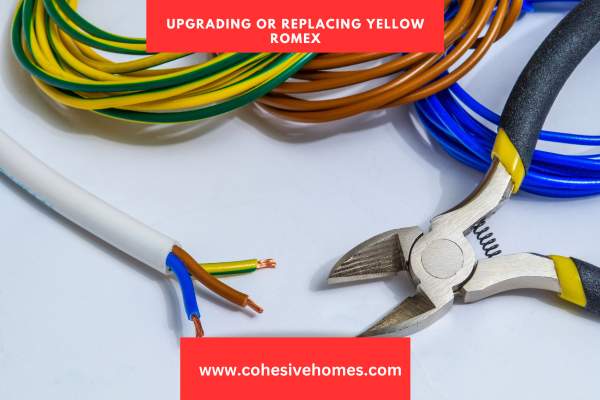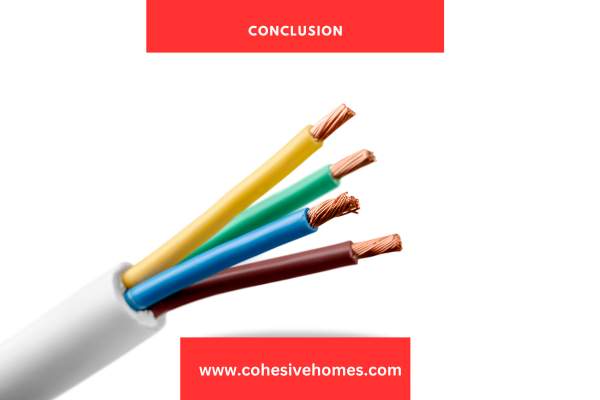Hey there, DIY enthusiasts and electrical novices! Are you ready to dive into the colorful world of Romex wiring? We’ve all been there, staring at those rolls of cable, trying to decipher their secret codes. “What gauge is this one?
Today, we unravel the mystery of yellow Romex, the vibrant wire commonly found in our homes.
Romex, for those unfamiliar with the term, refers to a brand of non-metallic (NM) electrical cable widely used in residential wiring. Its distinctive yellow sheathing catches our attention, making it a topic of curiosity.
But what does the yellow color signify? Is there any special gauge or purpose behind it? Let’s find out together!
In this blog post, we’ll be taking a conversational and down-to-earth approach as we explore the gauge of yellow Romex and the role it plays in our electrical systems.
We’ll demystify the world of electrical wiring, making it accessible to all, whether you’re a seasoned DIYer or someone just starting to dip their toes into the electrifying world of home improvements.
What is Romex Wiring?

Romex wiring is a popular electrical cable brand used for residential wiring in the United States. It has become the go-to choice for many homeowners and electricians due to its convenience, flexibility, and cost-effectiveness.
Romex wiring consists of two or more insulated conductors encased in a plastic sheath, typically made of PVC (polyvinyl chloride).
The conductors typically consist of copper, although certain applications may involve the use of aluminum conductors.
The plastic sheathing provides insulation and protects the wires from external damage.
One of the distinguishing features of Romex wiring is its color-coding system.
Each type of Romex cable has a specific color sheathing, which helps identify its intended purpose and electrical characteristics.
For example, people commonly associate yellow Romex with a specific gauge and utilize it for a particular function in residential electrical installations.
People primarily use Romex wiring for permanent electrical installations within the walls, ceilings, and floors of buildings.
Romex wiring powers outlets, switches, lighting fixtures, and more in homes, offices, and commercial buildings.
It’s important to note that while Romex wiring is widely used, it must be installed in accordance with electrical codes and regulations to ensure safety.
Proper installation techniques, adherence to local codes, and knowledge of the appropriate wire gauge are crucial factors to consider when working with Romex wiring.
Understanding Romex Wire Colors

Understanding Romex wire colors is essential when it comes to working with electrical wiring. The color-coding system used in Romex cables helps identify the specific purpose and characteristics of each wire within the cable. Let’s take a closer look at the common Romex wire colors and their meanings:
- Black:
Black wires in Romex indicate the “hot” wire, carrying electrical current from the power source to devices/outlets. These wires carry electrical current and require cautious handling. - White: White wires are known as the “neutral” wires in Romex cables. They provide a return path for the electrical current back to the power source, completing the circuit. Neutral wires are not usually connected to switches or outlets and are commonly found in bundles within electrical boxes.
- Bare Copper or Green: Bare copper or green wires are the “ground” wires in Romex cables. Their purpose is to provide a safe path for electrical currents in the event of a fault or short circuit. Ground wires are connected to grounding terminals, grounding screws, or grounding wires within electrical devices and metal boxes.
- Other Colors: In addition to the black, white, and bare copper/green wires, you may encounter additional colors in Romex cables. These colors are often used for specialized purposes, such as red wires for alternate “hot” lines, blue wires for three-way switches, or yellow wires for specific gauges.
It’s important to note that the color-coding system in Romex cables is not universal across all countries or regions.
Therefore, it’s crucial to consult local electrical codes and regulations to ensure accurate identification and safe usage of wires.
When working with Romex wiring, always follow proper safety procedures, such as turning off the power supply, using appropriate tools, and consulting a qualified electrician or local building authorities when necessary.
Understanding the meaning behind Romex wire colors will help you navigate electrical installations with confidence and ensure a reliable and secure electrical system in your home or building.
Demystifying Yellow Romex

Yellow Romex is a distinctive type of electrical cable that often piques curiosity due to its vibrant color.
It stands out amidst a sea of white, black, and other colored wires, sparking questions about its purpose and significance.
So, let’s dive into the world of yellow Romex and shed some light on its mysteries.
Yellow Romex, also known as NM-B cable, is a specific variant of Romex wiring commonly used in residential electrical installations.
Its yellow sheathing serves a specific purpose in electrical systems, signaling its gauge and intended applications.
The gauge of yellow Romex refers to the thickness or size of its conductive copper wires.
Yellow Romex commonly has a 12-gauge size, indicated as “12/2” or “12/3,” denoting two or three conductors.
The number 12 signifies the wire gauge, representing a 12-gauge wire, which is thicker and capable of handling higher electrical currents compared to smaller gauges.
Typically, people use yellow Romex with a 12-gauge wire to power outlets, switches, and lighting fixtures throughout residential buildings.
It can safely handle the electrical load associated with these applications, ensuring efficient power distribution and minimizing the risk of overheating or circuit overloads.
While yellow Romex is commonly associated with 12-gauge wire, it’s essential to note that different gauges can also be found in yellow Romex cables, depending on specific electrical requirements.
For instance, yellow Romex may also be available in 10-gauge or 14-gauge options, catering to different load capacities and installation needs.
Yellow Romex in Practice: Real-World Examples

Yellow Romex, with its distinctive color and specific gauge, finds numerous practical applications in residential electrical installations. Let’s actively explore some real-world examples of common uses for yellow Romex.
Powering Outlets and Receptacles
Yellow Romex is frequently employed to connect electrical outlets and receptacles throughout homes. It carries the electrical current from the circuit breaker panel to the outlets, allowing you to plug in and power various devices and appliances.
Lighting Fixtures
Whether it’s ceiling lights, wall sconces, or recessed lighting, yellow Romex is the go-to choice for wiring these fixtures. It ensures a safe and reliable connection, enabling you to brighten up your living spaces.
Kitchen and Bathroom Wiring
People often utilize yellow Romex in kitchens and bathrooms, where electrical demands are higher due to the presence of appliances, outlets, and lighting fixtures.. From countertop outlets to overhead lighting, yellow Romex provides the necessary power for these areas.
Basement Electrical Systems
When it comes to wiring the electrical systems in basements, yellow Romex comes into play. Basements often require multiple outlets, lighting circuits, and even special-purpose wiring for appliances like washers and dryers. Yellow Romex handles these demands efficiently and safely.
Garages and Workshops
From powering tools and machinery to providing lighting for workspaces, people commonly employ yellow Romex in garages and workshops. It enables you to set up a functional electrical system in these areas, supporting your DIY projects or hobbies.
Additional Circuits
As households grow and electrical needs expand, additional circuits may be required. Yellow Romex is often used to install new circuits, ensuring a safe and dedicated power supply to meet the increasing demands of modern living.
Remember, when working with yellow Romex or any electrical wiring, it’s crucial to follow safety guidelines, adhere to local electrical codes, and consult a qualified electrician if needed.
Approach electrical work with caution to prevent accidents and ensure a reliable and efficient electrical system.
Safety Considerations and Code Compliance

When working with electrical wiring, including yellow Romex, safety should be a top priority. Adhering to safety considerations and code compliance ensures the well-being of both yourself and your home.
Let’s explore some essential safety considerations and code compliance guidelines:
| Safety Considerations and Code Compliance |
| 1. Turn off the power before starting any electrical work. |
| 2. Use the proper tools and equipment for the job. |
| 3. Follow electrical codes and regulations specific to your area. |
| 4. Select the correct wire gauge based on circuit ampacity requirements. |
| 5. Secure and protect wiring to prevent damage and electrical faults. |
| 6. Ensure proper grounding of circuits and devices. |
| 7. Seek professional help if unsure or for complex installations. |
Upgrading or Replacing Yellow Romex

Upgrading or replacing yellow Romex may be necessary in certain situations, such as when renovating a property, addressing electrical issues, or enhancing the electrical capacity of your home.
Before embarking on this endeavor, it is important to assess the need for an upgrade or replacement.
If you are experiencing electrical problems, such as frequent tripping of circuit breakers, outlets not functioning correctly, or dimming lights, it may be an indication that your current wiring needs attention.
Additionally, if you are planning to add new electrical appliances, outlets, or lighting fixtures that require a higher electrical load, upgrading the wiring may be necessary to ensure safe and efficient power distribution.
Moreover, if you have an older home with outdated wiring systems, it is advisable to consider upgrading to meet modern safety standards and accommodate the electrical demands of contemporary living.
In such cases, replacing the existing yellow Romex with new wiring may be the best course of action.
Before proceeding with the upgrade or replacement, it is essential to consult a qualified electrician who can assess your electrical system, provide expert advice, and ensure compliance with local electrical codes and regulations.
They will be able to evaluate the current state of the yellow Romex wiring, identify any potential issues or safety concerns, and recommend the appropriate course of action.
When upgrading or replacing yellow Romex, it is crucial to plan the project carefully.
This involves determining the scope of work, including the areas where the wiring will be upgraded or replaced, obtaining the necessary permits if required by local authorities, and creating a timeline for the project.
It is important to factor in any disruptions to electrical service during the process and make arrangements accordingly.
During the upgrade or replacement process, it is essential to follow proper safety procedures.
This includes turning off the power to the circuits being worked on, using appropriate tools and equipment, and ensuring proper grounding and insulation of the new wiring.
It is advisable to work with a licensed electrician or a qualified professional to ensure the work is done safely and according to code.
Conclusion

In conclusion, upgrading or replacing yellow Romex wiring can be a crucial step in ensuring the safety, efficiency, and functionality of your electrical system.
Whether you’re addressing existing issues, accommodating increased electrical loads, or upgrading outdated wiring, it’s important to assess the need, consult with a qualified electrician, and plan the project carefully.
By following safety protocols, adhering to local codes and regulations, and working with professionals, you can successfully upgrade or replace yellow Romex, providing a reliable and secure electrical infrastructure for your home or building.
Investing in the upgrade or replacement of yellow Romex wiring not only enhances the electrical capacity but also offers peace of mind, knowing that your electrical system is up to code and capable of meeting your present and future needs.
FAQS
What is the purpose of the yellow sheathing on Romex wiring?
The yellow sheathing on Romex wiring serves as a distinguishing feature, indicating the wire gauge and intended applications of the cable. It helps identify yellow Romex as a specific variant within the Romex wiring family.
Is yellow Romex only available in one gauge?
No, yellow Romex is available in different wire gauges, although the most commonly found gauge is 12. Depending on specific electrical requirements, you may also find yellow Romex in 10-gauge or 14-gauge options.
Can yellow Romex be used for outdoor installations?
Yellow Romex is generally not suitable for outdoor installations unless it is specifically labeled for outdoor use. In outdoor applications, it is recommended to use wiring designed for exterior environments, such as UF-B (underground feeder) cable or other approved outdoor wiring.
